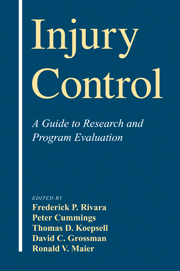Crossref Citations
This Book has been
cited by the following publications. This list is generated based on data provided by Crossref.
Smith, G S
2001.
Public health approaches to occupational injury prevention: do they work?: Figure 1.
Injury Prevention,
Vol. 7,
Issue. suppl 1,
p.
i3.
Blackmore, C. Craig
and
Cummings, Peter
2004.
Observational Studies in Radiology.
American Journal of Roentgenology,
Vol. 183,
Issue. 5,
p.
1203.
Trifiletti, L. B.
Gielen, A. C.
Sleet, D. A.
and
Hopkins, K.
2005.
Behavioral and social sciences theories and models: are they used in unintentional injury prevention research?.
Health Education Research,
Vol. 20,
Issue. 3,
p.
298.
Vernick, J S
2006.
Injury Prevention Policy Forum.
Injury Prevention,
Vol. 12,
Issue. 6,
p.
382.
Keyserling, W. Monroe
and
Smith, Gordon S.
2007.
Using Process Control Concepts to Model Conditions Required for Sudden-Onset Occupational Injuries.
Journal of Occupational and Environmental Hygiene,
Vol. 4,
Issue. 7,
p.
467.
Petrass, L A
Finch, C F
and
Blitvich, J D
2009.
Methodological approaches used to assess the relationship between parental supervision and child injury risk.
Injury Prevention,
Vol. 15,
Issue. 2,
p.
132.
Bell, Nathaniel
and
Schuurman, Nadine
2010.
GIS and Injury Prevention and Control: History, Challenges, and Opportunities.
International Journal of Environmental Research and Public Health,
Vol. 7,
Issue. 3,
p.
1002.
Hu, Guoqing
Rao, Keqin
and
Baker, Susan P
2010.
Non-fatal injuries among Chinese aged 65 years and older: findings from the Fourth National Health Services Survey.
Injury Prevention,
Vol. 16,
Issue. 4,
p.
230.
Kamal, Nashwa Nabil
2013.
Home Unintentional Non-fatal Injury Among Children Under 5 Years of Age in a Rural Area, El Minia Governorate, Egypt.
Journal of Community Health,
Vol. 38,
Issue. 5,
p.
873.
Tin Tin, Sandar
Woodward, Alistair
and
Ameratunga, Shanthi
2014.
Estimating bias from loss to follow-up in a prospective cohort study of bicycle crash injuries.
Injury Prevention,
Vol. 20,
Issue. 5,
p.
322.
Watson, Michael
Benford, Penny
Coupland, Carol
Clacy, Rose
Hindmarch, Paul
Majsak-Newman, Gosia
Deave, Toity
and
Kendrick, Denise
2014.
Validation of a home safety questionnaire used in a series of case-control studies.
Injury Prevention,
Vol. 20,
Issue. 5,
p.
336.



